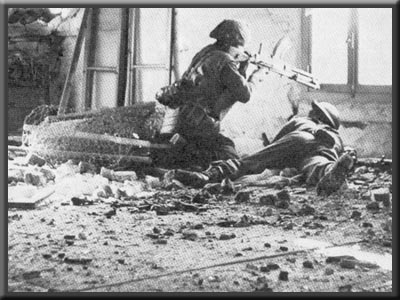
Canada and WW2 - Ortona
| Ortona “Little Stalingrad”
|
|
The Battle of Ortona took place during the heart of the Italian offencive by the Allied forces in December of 1943. Ortona is a costal town located on the Southwest coast of Italy. The attack on Ortona lacked in operational sense, but due to the winter season making mountain movement impossible and the fact that the Germans reinforced the city with the 1st Paratroop Division, the Allied planners went ahead with the plan to assault Ortona. Here is a chronology of the battle:
Dec.20th Dec. 21st
Dec. 22nd “Unit pioneers set a “beehive” demolition charge in position against the intervening wall on the top floor and exploded it while the attacking section sheltered at ground level. Before the smoke and dust had subsided the infantry were up the stairs and through the gap to oust the enemy from the adjoining building. In this manner the Canadians cleared whole rows of houses without once appearing in the street” (Nicholson, Canadians in Italy, pg.327) - after two days Canadians have advanced only 600 yards Dec. 23rd
Dec. 25th Dec. 28/29th Ortona would mark one of the bloodiest battle in the war for Canada. Casualty rates were high – exemplified by the Loyal Edmontons who had 173 Cas. (63 fatal) making up one third of the regiment of 600. Even more alarming were the rates of battle exhaustion (shell shock) for those involved, which were around 20-30% bringing about a morale crisis and causing both regiments to rotate back to reserve status for basically the remainder of the Italian Campaign. Ortona also marked the final “public” battle on the Italian front for Canadians, as Normandy was only 6 short months away. What must be remembered about those who fought in Ortona and the Italian Campaign is how difficult the fighting was that they endured in a place where they were not necessarily considered liberators, and how they have become the “forgotten” front in the war. Without the Italian front, the Germans could have shifted valuable resources to the Western and Eastern fronts which would have certainly made a difference in the Allied offensives in both regions. |
Published on: 2004-08-05 (32856 reads)
Recent Reviews
- War Horse 2012-01-02
- Legion 2010-01-23
- Zombieland 2009-10-02
- The Martyr's Oath: The Apprenticeship of a Homegrown Terrorist 2009-08-20
- Bachman Cummings 2009-06-22
- Star Trek 2009-05-03
- X-Me Origins: Wolverine 2009-05-01
- Soloist 2009-04-24






